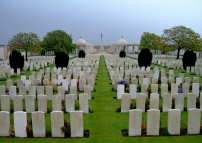| First Name: | Reginald Percy | Last Name: | SMITH | |
|---|---|---|---|---|
| Date of Death: | 25/09/1915 | Lived/Born In: | Regent's Park | |
| Rank: | Private | Unit: | Somerset Light Infantry8 | |
| Memorial Site: | Loos Memorial, France | |||
Current Information:Born-St Pancras The Battle of Loos 25th September - 13th October 1915 This was fought by the British Army along a six-and-a-half-mile front running north from the mining village of Loos on the outskirts of Lens in Northern France. It was the largest offensive carried out by the British so far. The opening day involved an attack by six divisions, with others entering the fray as it progressed and it was part of a much wider offensive with the French launching their own attacks in Champagne and at Vimy. It was the first time that the British used gas during the war, despite their condemnation of the Germans for doing the same in April 1915. There were some encouraging results on the first day but no major breakthrough was achieved and in the succeeding days of it became bogged down in brutal trench warfare. By mid-October the battle had petered out with the British having suffered over 60,000 casualties during its course. The reserve Corps for the battle, XI Corps, consisted of the Guards Division and two New Army divisions, 21st Division and 24th Division, made up of volunteers who had responded to Kitchener’s appeal, and who had only arrived in France at the beginning of September 1915. Nevertheless they were soon in battle. Field Marshal French kept them back from the front when the main attack went in on 25th September but when things did not go to plan these reserves were urgently called for. Even so they were held back until the last minute which meant that they had to march across country through a night of heavy rain to reach the battlefield. It was not until the late morning of 26th September that they were in position to assault the German second line between Bois Hugo & Hulluch. But by this time the enemy had brought up reserves and were launching counter attacks which further disrupted proceedings. What happened next was a disaster. Advancing in broad daylight in ten columns, without the help of an artillery barrage these totally inexperienced divisions were cut to pieces by machine gun and rifle fire. They lost half of their number in a matter of minutes. Even the Germans were shocked at the slaughter and stopped firing to allow the survivors to withdraw. During the night of 25th-26th September, 63 Brigade of 24th Division reached Fosse 7 around 8pm but the Divisional instructions to stay put there did not reach them in time and their advance continued with 8th Lincolnshire and 12th West Yorkshire leading and 8th Somerset Light Infantry and 8th Lincolnshire following behind. At 3am they reached the Lens road near Chalk Pit where they relieved the remnants of 2 Brigade, 1st Division and then had to wait in these unwired positions until they attacked at 11am on 26th September. The enemy defences here consisted of only one trench but it was well protected by wire and at its ends and middle by three strong closed works, Stützpunkte III, IV & V plus a number of concrete machine guns emplacements making it a very strong position, comparable to their original line What’s more it had been reinforced during the night and now six German battalions manned its one mile long stretch. When the attack went in, 8th Somerset Light Infantry were in brigade reserve and two companies were sent to line the southern edge of Chalk Pit facing Bois Hugo forward but when, just after midday, the attack of 21st Division and 24th Division faltered, stopped and then fell back, so did 8th Somerset Light Infantry until they were all rallied on Lone Tree Ridge. Casualties for 8th Somerset Light Infantry during this action amounted to nearly 300. |
||||
| « Back to Search Results | ||||
| If you think any of the information shown here is incorrect, Click Here to submit your amends and comments | ||||




